by Winding Pathways | Nov 30, 2015 | Mammals, Nature, Pests
We love watching frolicking squirrels in our yard and every year we buy bags of corn for them to snack on. We draw the line when they climb up to feeders and gobble expensive seeds meant for chickadees, nuthatches, and woodpeckers.
Bird feeder companies all tout their “squirrel proof” feeders and a homeowner can spend a bundle on different feeders just to slow the flow of seed from feeder to squirrels’ mouths. Some preventions work better than others but a reliable company is Droll Yankee.
But, being partly of Yankee stock, we took the economical route. To thwart the hungry mammals we mounted our feeders on steel pipes and even ringed some with metal stove pipe. Somehow they managed to dig claws into the metal, climb and feast on expensive seed.
Then we discovered spray grease. It’s sold in hardware stores and is meant to spray on drawer slides, hinges, and other balky metal parts. We sprayed it on the metal pipes holding up the feeders. Squirrels gingerly put their feet on the pipe and backed off as soon as they felt the grease. It works.
Spray grease only lasts a few weeks and needs to be reapplied, but it is a simple way to discourage squirrels from climbing to feeders.
-
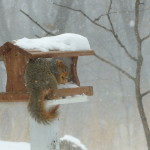
-
Even in the teeth of a storm, squirrels feast to tide them over.
-
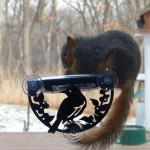
-
Boldly the fox squirrel hunkered down at the window feeder.
-
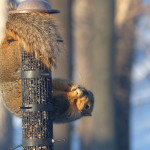
-
Quite the acrobat, this squirrel hung for more than 30 minutes eating seed.
-
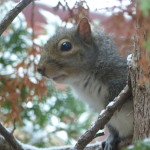
-
A cautious squirrel scoping out the action.
-
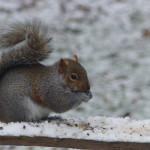
-
A hungry squirrel
-
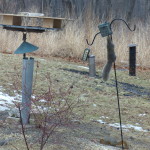
-
Squirrels have an amazing ability to climb just about any vertical pole.
-
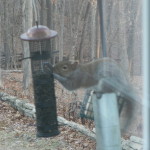
-
This squirrel learned to climb the metal deflector pole and reached into the hanging feeder.
-
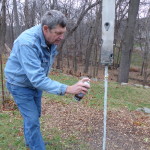
-
This grease works for a while. Remember to re-apply.
by Winding Pathways | Nov 28, 2015 | Birds, Children/Play, Labyrinths, Nature, Travel/Columns, Wonderment
-
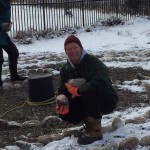
-
Lisa organizing the build.
-

-
Hudson, WI, has a new labyrinth at Healing Waters Health Center. Created by Lisa Gidlow Moriarty and assisted by several volunteers.
-
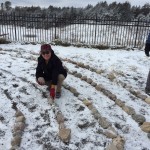
-
Carefully laying stone in the new labyrinth
What fortune to have contacted Lisa Gidlow Moriarty who was constructing a labyirnth at Healing Waters Health Center in Hudson, WI. Rich and I joined the crew and after the lines were drawn using high technology of a bucket and rope and a tire iron to gouge the circuits, we placed rocks that had been hauled in. The concentric circuits quickly asserted themselves and the labyirnth was completed in no time at all! The day was cold, but the hearts and spirits warm. What a fun experience.
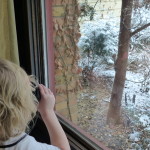
The children are quick to spot birds and squirrels.
Time with extended family in the Twin Cities was restful and hilarious as the children explored outside, spotted birds with “noculators”, and constructed wonderful toys from Legos.
Thanksgiving morning four of us walked a lovely labyrinth at St. Patrick’s Catholic Church in Plymouth, MN. Set down in a barrow area, the labyrinth is formal, well-maintained and has a light feel to it. While set apart, it is visible and still private. Well done.
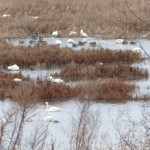
Along the Mississippi
Our drive back along the Mississippi River yielded a fabulous view of Tundra Swans near Minneiska, MN, and a really terrific lunch at a humble looking (on the outside) but spectacular on the inside creamery now restaurant, wine tasting stop and cheesery near Alma, WI. Pretty fabulous. And, the countryside of The Driftless” area (NE Iowa, NW IL, SE MN and SW WI) is gorgeous even on grey November days. Decorah, IA, boasts are pretty great coffee shop and small businesses.
by Winding Pathways | Nov 24, 2015 | Birds, Chickens, Nature
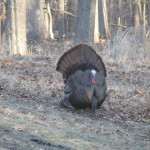
Strutting his stuff
As we enjoy Thanksgiving dinner we pay homage to the great gift the Americas gave the world.
Beef, pork, lamb, and chicken all come from animals with Old World origins. Shortly after Europeans discovered North and South America, Australia, New Zealand, and other new worlds they introduced these familiar and useful farm animals. Before Columbus made landfall, Native Americans knew nothing about these exotic animals. But, they knew turkeys.
Of all common meat animals eaten today only turkeys came from the New World. Before Columbus, wild turkeys abounded across much of North America. Their domestic cousins were tended by some tribes. Treated with great care, the domesticated turkeys were an important source of clothing, tools and food. Among some uses of the tribes of the Four Corners of the United States, turkeys provided feathers for coats, eggs for eating and reproduction, and bones for tools. Evidence exists that the Native Americans cross bred for certain valued characteristics. Europeans quickly developed a taste for turkey and brought them eastward across the Atlantic where they became a common European food.
Our Thanksgiving dinner consists of turkey, potatoes, and winter squash, all Native American foods. Sometimes we add acorn muffins and capstone the meal with a long time family recipe for pumpkin pie, made from a plant that also originated here.
by Winding Pathways | Nov 2, 2015 | Mammals, Nature, Pests
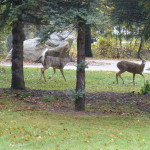
On Halloween day a buck was hot on the “tail” of this doe and yearling.
Drivers, be cautious! Across most of North America early November is the most likely time for a car to collide with a deer. Too often it happens even in suburban neighborhoods and a collision usually does extensive damage to a car, injures or kills the deer, and sometimes even people are killed or hurt.
At our home at Winding Pathways we watched a buck chase a doe on Halloween afternoon. That’s slightly early, but during the next two weeks more cars will hit deer than in any other time period in the year.
In early November female deer come into estrus in northern states with peak activity a week or two later in the south. Big antlered bucks have the uncanny ability to stay out of sight most of the year, but in November they abandon caution and run through backyards and cross roads at any time of day or night. A doe in heat is usually followed closely by an eager buck.
Within weeks nearly all does will be pregnant and the rut fades, but usually it’s followed by a somewhat less intense breeding time in about a month when any nonpregnant does mate. By Christmas nearly all does are pregnant and will give birth late next spring.
When driving through deer territory always be careful, but in early November be especially cautious. Go easy on the gas pedal, keep your eyes open and if one deer crosses the road in front of you expect others to follow. Look in the direction the deer came from. Others likely will be about to cross.
An interesting overview on deer rutting can be found at The Noble Foundation.
by Winding Pathways | Sep 15, 2015 | Bugs, Nature
As leaves tumble off our trees each fall we usually spot one or two round or football shaped gray wads of paper clinging to branches. They’ve been there all summer but hidden by leaves.
This fall many people will discover similar baldfaced hornet nests and be alarmed that they’re sharing their yard with stinging insects.
A fertile bald faced hornet queen overwinters under a log or in the ground. As the weather warms she flies to a branch and makes a tiny nest of paper-like material. She’ll lay an egg or two that hatches into a worker. Workers forage for tasty insect food and expand the nest. As the nest grows the queen lays more eggs until the colony has many hornets. By summer’s end it’s full size just before leaves begin to fall.
Bald Faced hornets are normally content to go about their business building their nest and catching tender insect food. They have little interest in stinging people unless someone molests their nest. Get too close or bother the nest and you likely will get stung many times. Dozens of hornets will instantly attack and multiple stings are the norm.
There’s a simple way to avoid being stung. Leave the nest alone. That may be easier said than done. A few years ago a neighbor teenager spotted a nest in a backyard tree. He hurled rocks at it, and his aim was good. Angry hornets boiled out and attacked! The boy retreated in pain but with an education he won’t forget.
As the weather cools the colony creates more queens that mate and then find a snug place to overwinter in solitude. Worker hornets die and the nest soon becomes empty and disintegrates during winter wind and snow.
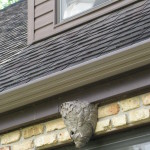
A bald faced hornet nest by a front entry. Leave it be until freeze up.
If you find a hornet nest in early to mid-fall LEAVE IT ALONE. It may still be occupied. If it must be removed wait until cold weather sets in. By then it will be abandoned and can be removed safely. At Winding Pathways we leave our nests in place and gradually watch them disintegrate.
by Winding Pathways | Sep 12, 2015 | Mammals, Nature, Pests, Trees/Shrubs
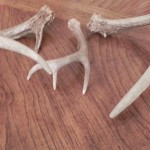
A pair of winter sheds all polished.
One year at Winding Pathways we planted a few trees and tended them all summer. They were doing great until one September night. A buck deer decided that our new trees were perfect for rubbing off the velvet that covered his newly formed antlers. Just a few minutes of determined rubbing killed our precious trees!
Deer antlers start growing in early spring and by late August are fully formed. Velvet on the outside of the growing antlers is rich with blood and minerals. By September its purpose is done. Bucks rub the velvet off to prepare their antlers for battle with rivals when the mating season starts in November.
Deer have the uncanny knack of rubbing the most valued trees in a yard, and often they remove all the bark, thus killing the tree.
Fortunately, damage is easy to prevent. Just drive fence posts into the ground a few feet out from the tree and attach wire mesh to them to physically keep deer away. Plastic tree guards that attach directly to the trunk also help prevent damage.
Do this now before the deer start to rub. Or you may lose all your new trees in just one night.

















